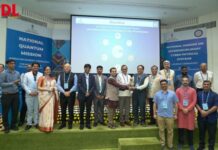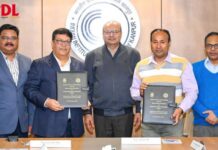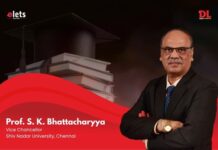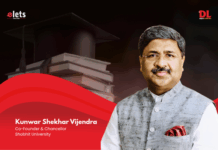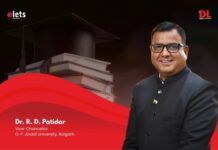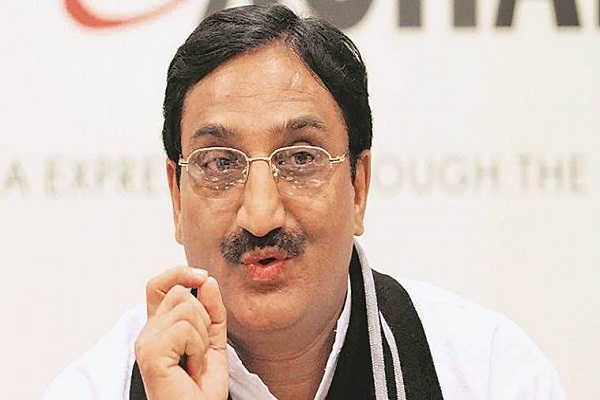
While school education is not a mandate of DST, we do want greater introduction to and participation of schools students in generation of creative ideas, in innovation etc. The base of the knowledge and innovation pyramid needs to be broadened, not just its height. The culture of innovation has to be seeded in schools, says Prof Ashutosh Sharma, Secretary, Department of Science and Technology (DST), Government of India in an exclusive interview with Sanghamitra Mohanty of Elets News Network (ENN).

You talked about strengthening the academic institutions through the latest equipments, funding for research and everything. There is a parallel system emerging of private universities. Is the DST also engaging in them?
The DST focuses very tightly on two or more different things. One is competitiveness; other is quality and the third is relevance. Now we are agnostic to who is competing for this. Of course, some of the private universities are bringing greater emphasis on research, and they deserve the support. But they have to compete with the rest, both public and private. If the scientific advisory expert committees find their projects competitive, we do fund them in PPP mode. We do encourage and support research in the best of universities including private universities, to enhance the quality of teachers, teaching, and students. Scientists need to be creative, they need to be fired a little bit, need to be excited, and so if they have all of that, their energies will find fulfilment in contributing to socio-economic growth rather than petty mischief.
A lot of Council of Scientific and Industrial Research (CSIR) organisations exist all over the country, how do you link the university system with them?
While CSIR is primarily focused on supporting their labs, DST’s funding is agnostic to who applies for it, competitive excellence and relevance being the only criteria. Even CSIR scientists apply for funding from DST. Clearly, research is best not done in silos. One of the things we are encouraging continuously is also to seed research which is not based solely on a discipline or tool. The historical way of funding research was in chemistry, physics, mathematics, biology, chemical engineering, material engineering, etc. Now a lot of our recent efforts are in addition also focused on the problem centric research. Sometimes you call it discovery research versus solutions research. Now what is important about solutions research is that it is interdisciplinary. Suppose there is a problem with water, it cannot be solved only by Chemistry. You need different people with different backgrounds working together. So we are also encouraging this kind of research with programmes and missions in water, renewable energy, cleaner fuels,management of energy, manufacturing science, waste processing, etc.
There is a mission on Science and Technology of Yoga and Meditation (SATYAM) which started about four years ago. It is an interdisciplinary subject, which uses the best of the tools and processes of modern science to probe the underlying biology behind traditional wisdom. There is a plethora of clinicians and scientists from places such as All India Institute of Medical Sciences (AIIMS), National Institute of Mental Health and Neuro-Sciences (NIMHANS), Postgraduate Institute of Medical Education and Research (PGIMER)-Chandigarh, who are working together on these projects by use of tools such as the Functional Magnetic Resonance Imaging (FMRI) to map the brain in neurology investigations. 
Coming back to the point, how do you integrate scientists with diverse backgrounds and expertise to work on significant interdisciplinary problems? You encourage them by offering huge stimulating challenges, so by working together, one can do extraordinary things at a scale not possible by a single group. So we set aside some funding in order to form these networked groups. This is solution science, and I gave you some examples.
These examples are also important because these are some things for which earlier there was no funding. For example, there was no programme for manufacturing science. Beyond the traditional silos of S&T such as chemistry, physics, engineering of various kinds, etc. there is another way to categorise all of S&T as being made up of five M’s of doing science! These are Mechanics, Materials, Machines (devices, systems, etc), Manufacturing (and fabrication) and finally, Man! This is something I like to share in lectures and conferences. It doesn’t really matter whether one is a chemist or a physicist, or whoever, basically there are these five Ms that one usually focuses on: Mechanics, which is the understanding of how and why of things and phenomena; Materials, one needs appropriate material to be able to do anything; Machine, System or a device which is a synthesis for a purpose or function; and Manufacturing, which is requires taking into account inputs from the other Ms. This is the last mile connectivity of research with society.
The last M signifying Man or Woman is something special. It is about taking into account the relation of S&T with the needs and priorities of Society in all its forms. This is indeed the prime mover of all applications of S&T keeping in view their context, relevance and usefulness. An easy way to appreciate it to see that the concept and practice of Industry 4.0, powerful as it may be, has to be a sub-set of Society 5.0, which keeps the Man, rather than technology, at the centre.
You are only talking about increasing the manufacturing sector in the country but we haven’t yet had a focused research area.
We have seeded a R&D programme in advanced manufacturing science, which together with the Hubs of Cyber- Physical Systems (Industry 4.0) and Technology Business Incubators and SATHI Centres form the pillars of support to manufacturing. Earlier, focus has been rather exclusively on materials and mechanics, and little bit on machines, which requires a synthesis of knowledge. Actually much of what we do in college and universities education is mechanics and others are relegated to specialised courses. So while we do need to focus on mechanics or materials for very compelling reasons, that focus cannot be exclusive, because we also need to close the circle of knowledge by inclusion of manufacturing and innovation. So there can be five Ms for doing any kind of science: Mechanics, Materials, Machine, Manufacturing and Man/Woman.
An example of the cutting-edge manufacturing science is in a recent Railways Technology Mission, where DST is partnering with the Railways to equip one of the Coach Factories with the processes and resources of Industry 4.0 based largely on indigenous technologies.
It’s almost like re-inventing DST, in last five years.
It is a re-positioning owing to the rapidly changing landscape of S&T globally. Nothing should be static! The basic mantra has been to enhance quality in basic research; improve relevance, connects and delivery in applied research; add solution-science areas that need attention; and seed emerging disruptive areas in time to secure our future.
Fortunately, in the last five years, DST’s budget nearly doubled, which has been rather unprecedented. So we are able to maintain our support of quality basic research and in fact its scale up in view of the increased number of scientific institutions. A new scheme to encourage profound and disruptive science has also been introduced that allows scientists to undertake high risk research based on exceptionally novel ideas. In fact, the budget of Science and Engineering Research Board (SERB), an arm of DST for basic research, has also doubled allowing it to initiate new needed schemes for national post- doctoral fellowships, young scientists etc. while increasing its support for PI-centric projects.
The new programmes on emerging relevant technologies from manufacturing to clean energy to water to environment to transport to cyber- physical systems to quantum systems to other disruptive areas all have a compelling basic science component. The new ingredient is not to simply stop with that, but allow our processes to go beyond to technology, innovation, to industry and societal connects. Fortunately, bringing in new areas and elements has not been a zero sum game owing to substantial increase in the budget.
How are you envisioning the schools?
While school education is not a mandate of DST, we do want greater introduction to and participation of schools students in generation of creative ideas, in innovation etc. Our PM has often pointed out that although we have millions of problems, we also have a billion minds to address them! The base of the knowledge and innovation pyramid needs to be broadened, not just its height. The culture of innovation has to be seeded in schools. Today we have maybe about 10,000 tech based start-ups, but with the size of India, we need not 10,000 but 100,000 or even 1000,000 start-ups! How are we going to add these extra zeros with speed? It’s not going to happen only from the elite and higher education institutions. That is only the tip of the iceberg.We need to take the gospel of innovation to every corner, to young minds, for the culture of problem-solving thinking to take roots. So this is something we can do by firing up the imagination of school students.
DST thus started a new programme, Million Minds Augmenting National Aspirations and Knowledge (MANAK). The idea is to reach out to five lakh schools in the country to have competitions for innovative ideas and select the top one or two ideas from each school which can be submitted in any of the 22 languages of the country on an online portal. So we start with five to 10 lakh ideas from which an army of evaluators sift through to select 50,000 top ideas. Each of these students gets an Rs 10,000 prize, part of which is to be used to convert the idea into a prototype. Thus, using their hands and brains, workshop facilities, mentorship and so on; we introduce two key elements of innovation:respecting the power of independent innovative ideas, and then the desirability to convert a good idea into reality.
These selected prototypes then compete on district levels, state level, and national level; 10 percent of the ideas going forward at each level. Higher levels attract greater rewards, mentorship, motivation, inspiration and so on. This is a step in building the future of innovations with numbers. I have talked to so many of MANAK awardees. It is very interesting because the nature of ideas one meets here will not come from a PhD student or from me! For example, a girl in 7th standard came up with the problem of the drinking water taps in her school being mounted very high for her height. Her solution was to give a tilt to the pipe on which the taps are mounted, so that she can drink from the lower side and the taller students can drink from the other side. These kids have appreciation of both the problem and the possible solutions. We need to scout, encourage, reward and mentor them. Another girl made an interesting design of a multipurpose mechanised toilet cleaning gadget appropriate for the design of rural toilets, which was inspired by seeing the difficulty of her mother’s work.
Now, National Innovation Foundation (NIF) at Hyderabad, which implements MANAK, is creating a data bank of these ideas. In terms of its scale and ambition, this is probably the largest programme that DST has ever launched.
What is the feedback?
It has been beyond our expectations since the programme is only two years old. Not only the feedback, we also did an analysis of outcomes on the lakhs of ideas that we got last year. The analysis covered demography of the winners, their composition in terms of gender, in terms of what kind of school they come from (Municipal Corporation supported versus Central Government supported versus private), where do they come from geographically (rural, urban), etc. How many are from the socially weaker sections? It turns out that the composition of winners parallels the demography of the country very closely. This is without any preferences built into the programme itself. This is very heartening in that it confirms that innovation, innovative thoughts, creativity are equally distributed across all sections of society, regardless of the gender, location, nature of school, socio-economic strata etc. So this is very heartening, because it means that this programme has a good future and it would be able to select and inspire young students equitably from among all the sections of society.
There is an IIT and NIT system, government universities system, there are science colleges where people are doing B.Sc., but somehow they remain less engaged with the IIT level stuff.
One of the reasons for that is, with many of the colleges, we don’t have students and teachers to do research, we don’t have the required infrastructure, and we don’t have a priority or culture or systems needed for research. In the absence of these, merely providing money for research is not an optimal solution. Capacity and culture for research needs to be created. So what are the possible solutions? While many of the interventions are envisaged in the new Education Policy of the MHRD, one modest beginning was made in a SERB/ DST programme called Teacher Associate for Research Excellence (TARE). The idea is to create a fertile soil and seeds for research in colleges.
There are of course lots of colleges with excellent young faculty, who have done good research during PhD, but are not able to pursue research because of the reasons that I pointed out. How do engage this latent research manpower? This TARE programme gives a fellowship to the faculty with a proven research track record, with research potential and a deep desire to pursue research. So this fellowship and some research money allow them to work in a neighbouring institution or university with a relevant research group.
It could be an IIT, IISER, Central University, R&D lab like CSIR, wherever they find a host group, which can provide them the infrastructure and advise to allow collaborative work in the evenings, on weekends, in holidays, etc. Now, already 500 of these fellowships have been given in one year. As long as these researchers continue to engage meaningfully with progress, they will continue in the fellowship. Anyway, upto 5,000 such people should eventually be pursuing research. It is hoped that some of them may be sufficiently empowered to write grant proposals and succeed.
There are also programmes for universities and colleges to strengthen their research infrastructure. One such programme is Promotion of University Research and Scientific Excellence (PURSE). Those universities that have good research performance are given a one- time grant for creation of scientific infrastructure. This grant could be up to Rs 30 crore. There are many state universities that are greatly helped by this mechanism.
You have been in the academia; you have been a researcher and a teacher, new to administration. Your job right now is policy making. How do you handle that?
Management of DST requires deep insights into our entire science and technology ecosystem, including education. My job as a professor provided deep insights into the ground realities of higher education, scientific research, human resources, technology development, intellectual property, and even start-ups. Professors are for life! These experiences and insights have been invaluable in identifying the challenges and opportunities and in formulations of schemes that identify and address the gap areas in an effective manner. So essentially, our new directions in DST came from the evidence-based analysis of strengths, weaknesses, challenges, opportunities, needs and gaps and how to systematically address them. So I think in a ministry like this, it is necessary to have a scientist.
We have two new needed policies under the final legs. The first one is on the Scientific Social Responsibility that we discussed earlier and the other one is on Management of Scientific Infrastructure including its creation, maintenance, effective use, sharing and disposal. Two other policies are in the pipeline on Geospatial Data and a comprehensive umbrella policy on S&T and Innovation.
And there is another thing, one of the weaknesses have been in our science communication. The scientific community as a whole is not very strong in communications of various kinds, like in scientific journals, in popular media.




